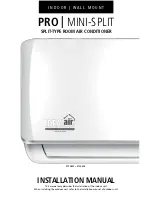
Page 52
KG/KC 024, 030, 036, 048, 060, 072, 074, 090
5- Move gas valve switch to
OFF
. See figure 24 or 25.
6- Wait five (5) minutes to clear out any gas. If you then
smell gas,
STOP!
Immediately call your
gas supplier from a neighbor's phone. Follow the gas
supplier's instructions. If you do not smell gas, go to
the next step.
7- Move gas valve switch to
ON
. See figure 24 or 25.
8- Close the control access panel.
9- Turn on all electrical power to appliance.
10- Set thermostat to desired setting.
NOTE - When unit is initially started, steps 1 through 9
may need to be repeated to purge air from gas line.
11- The ignition sequence will start.
12- If the furnace does not light the first time (gas line not
fully purged), it will attempt up to two more ignitions
before locking out.
13- If lockout occurs, repeat steps 1 through 10.
14- If the appliance will not operate, follow the
instructions “Turning Off Gas to Appliance” and call
your service technician or gas supplier.
Turning Off Gas to Unit
1- If using an electromechanical thermostat, set to the
lowest setting.
2- Before performing any service, turn off all electrical
power to the appliance.
3- Open or remove the control access panel.
4- Move gas valve switch to
OFF
.
5- Close or replace the control access panel.
WARNING
Danger of explosion. Can cause injury or
death. Do not attempt to light manually.
Unit has a direct spark ignition system.
Heating Operation and Adjustments
(Gas Units)
A-Heating Sequence of Operation
1- On a heating demand the combustion air inducer
starts immediately.
2- Combustion air pressure switch proves inducer
operation. After a 30-second pre-purge, power is
allowed to ignition control. Switch is factory set and
requires no adjustment.
3- Spark ignitor energizes and gas valve solenoid
opens.
4- Spark ignites gas, ignition sensor proves the flame
and combustion continues.
5- If flame is not detected after first ignition trial, ignition
control will repeat steps 3 and 4 two more times
before locking out the gas valve.
6- For troubleshooting purposes, an ignition attempt
after lock out may be re-established manually. Move
thermostat to “OFF” and return thermostat switch to
“HEAT” position.
B-Ignition Control Diagnostic LED's
TABLE 22
IGNITION CONTROL HEARTBEAT LED STATUS
LED
Flashes
Indicates
Slow
Normal operation. No call for heat.
Fast
Normal operation. Call for heat.
Steady Off
Internal control fault OR no power to
control OR Gas Valve Relay Fault.
Steady On
Control internal failure.
2
Lockout. Failed to detect or sustain flame.
3
Prove switch open or closed or rollout
switch open.
4
Limit switch is open and/or high limit has
opened three times.
5
Flame sensed but gas valve solenoid
not energized.
C-Limit Controls
Limit controls are factory-set and are not adjustable. The
primary limit is located to the right of the combustion air
inducer. See figure 30.
If the primary limit trips three times in the same heating
cycle, heating operation will de-energize. Heating will
automatically restart after one hour if a heating demand is
present. To initiate heating during the one hour timed-off
interval, reset the thermostat.
D-Heating Adjustment
Main burners are factory-set and do not require
adjustment.
The following manifold pressures are listed on the gas valve.
Natural Gas Units - Low Fire - 2.0” w.c.
Natural Gas Units - High Fire - 3.5” w.c.
LP Gas Units - Low Fire - 5.9” w.c.
LP Gas Units - High Fire - 10.5” w.c.
Electric Heat Start-Up (KC Units)
Optional electric heat will stage on and cycle with
thermostat demand. See electric heat wiring diagram on
unit for sequence of operation.





































